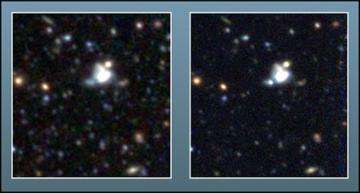'Champagne supernova' challenges understanding of how supernovae work

An international team of astronomers led by a group at the University of Toronto has discovered a supernova more massive than previously believed possible. This has experts rethinking our basic understanding of how stars explode as supernovae, according to a paper to be published in Nature on September 21.
University of Toronto postdoctoral researcher Andy Howell, lead author of the study, identified a Type Ia supernova named SNLS-03D3bb in a distant galaxy 4 billion light years away that originated from a dense evolved star, termed a 'white dwarf,' whose mass is far larger than any previous example. Type Ia supernovae are thermonuclear explosions that destroy carbon-oxygen white dwarf stars that have accreted matter from a companion star.
Researchers say SNLS-03D3bb’s “obesity” has opened up a Pandora’s box on the current understanding of Type Ia supernovae and how well they can be used for precision cosmology.
Current understanding is that Type Ia supernova explosions occur when the mass of a white dwarf approaches 1.4 solar masses, or the Chandrasekhar limit. This important limit was calculated by Nobel laureate Subrahmanyan Chandrasekhar in 1930, and is founded on well-established physical laws. As such, decades of astrophysical research have been based upon the theory. Yet, somehow the star that went supernova as SNLS-03D3bb reached about two solar masses before exploding.
"It should not be possible to break this limit," says Howell, "but nature has found a way. So now we have to figure out how nature did it."
In a separate News & Views article on the research in the same issue of Nature, University of Oklahoma professor David Branch has dubbed this the “Champagne Supernova,” since extreme explosions that offer new insight into the inner workings of supernovae are an obvious cause for celebration.
The team speculates that there are at least two possible explanations for how this white dwarf got so fat before it exploded. One is that the original star was rotating so fast that centrifugal force kept gravity from crushing it at the usual limit. Another is that the blast was in fact the result of two white dwarfs merging, such that the body was only briefly more massive than the Chandrasekhar limit before exploding. Observations of the supernova were obtained at the Canada-France-Hawaii telescope and the Keck telescope, both located on Mauna Kea in Hawaii.
Since Type Ia supernovae usually have about the same brightness, they can be used to map distances in the universe. In 1998 they were used in the surprising discovery that the universe is accelerating. While the authors are confident that the discovery of a supernova that doesn't follow the rules does not undermine this result, it will make them more cautious about using them in the future.
University of Toronto postdoctoral fellow Mark Sullivan, a coauthor on the research, says, “This supernovae muddies the waters. We now know these rogue supernovae are out there which might throw off our cosmology results if we aren't careful about identifying them.”
Source: University of Toronto




















